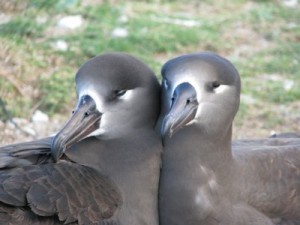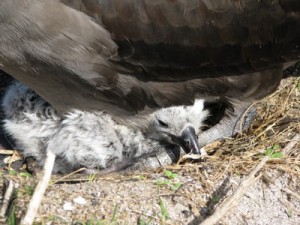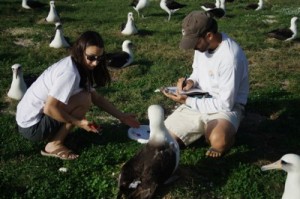After a lazy morning, we spent the early afternoon learning about the wonders of and surprising threats to the three species of albatross on Midway. Then, after practicing banding, we biked to Charlie Barracks where we put steel bands on Laysan albatross. In addition, we were lucky enough to view some fuzzy black-footed albatross chicks. (We have discovered a Laysan albatross with a pipped, or cracked, egg outside our living quarters, and will keep a close eye on it as it will likely hatch in 12 to 24 hours.)
Today we had our first lazy morning on the island. On Sundays our amiable Thai chef serves brunch—pepperoni pizza, Pad Thai, cherry pie, and lychee fruit. And as always, we enjoyed it over ocean breezes and soaring albatrosses.
In the afternoon, Marc Romano, a wildlife biologist with the U.S. Fish and Wildlife Service, Division of Migratory Birds and Habitat Program, gave a very interesting lecture on albatross ecology and conservation. As Marc described it: “In all ways seabirds are unique, but albatross push everything to the extreme.” They live longer than any other seabird. They mate for life. They wait until they are nine or 10 years old to raise their first chick. They can fly more than 600 miles in one day.

Three species of albatross nest in the North Pacific: Short-tailed, Black-footed, and Laysan. Its believed that the Short-tailed albatross originally numbered from two to five million; however egg collection and feather hunting reduced their numbers, so that now less than 2,000 roam the Pacific. In Midway atoll there are three.
In contrast, about 500,000 breeding pairs of Laysan albatross call Midway home. Black-footed albatross nests number nearly 50,000. Needless to say, Midway is for the birds. However, these birds still face numerous threats. Thousands of Laysan and black-footed albatross die in the pelagic longline fishery each year. Seven percent of the chicks on Midway succumb to lead poisoning as the paint chips off old buildings. Untold numbers of chicks perish with stomachs full of lighters and soda caps. Black-footed albatross may soon be listed under the Endangered Species Act.

Thankfully, Marc and the U.S. Fish and Wildlife Service are working to learn more about the reproductive success and survival rate of these birds through several long-term research projects. For one study, they band birds to document the survival of individuals and determine the potential longevity of the animals. We were given the unique opportunity to help out.
But before banding birds, we took a long bike ride to the coastal runway where most of the Black-footed nest. With seven-foot wingspans, Black-footed albatross require windy habitats to help them take flight. They begin nesting earlier than Lasyan, and so today we were lucky enough to see some of their first fuzzy chicks.
Chick-viewing accomplished, we set out to band birds. Marc trained us to carefully nudge the nesting albatross with padded golf clubs to see whether their legs were banded. Our task was to replace worn out aluminum bands with sturdy stainless steel bands. After we identified a bird that needed its band changed, we used spreading pliers to remove the old band before carefully replacing it. A tricky business, replacing the band requires a very strong squeeze with jury-rigged pliers; before we went to work on the birds, we practiced our technique on golf clubs.

Each old band number we removed was recorded to examine survivorship—back at the office Marc and his volunteers will enter these numbers into their database and age the birds. In 2003, Chandler Robbins, a wildlife biologist for USGS who began banding birds in the 1950s, returned to Midway and discovered one of the birds he had first banded. As of 2007, this bird was at least 55 years old, the oldest known seabird.
As we contemplated the oldest bird, we came across signs of the next generation. We banded a Laysan albatross with a pipped, or cracked, egg. Pipping indicates that the chick will likely hatch in the next 12-24 hours. The egg is right outside Hotel Charlie, our living quarters, so we plan to keep a close eye on it.

We ended the day at Midway Bowl, Sand Island’s 10-lane bowling alley. Constructed by the Navy during the 1960s, shoes come in all (men’s) sizes and balls begin at 11 pounds. This bowling alley is not for lightweights.
I must close with a cautionary note: Amblers at Midway beware. Though by day, diminutive Bonin petrels nestle quietly in their burrows, by night they whiz through the air, occasionally hitting certain bloggers square in the face.

What a beautiful bird and incredible photos. So which blogger forgot to duck??? Hope no one or bird was injured.
The blogger in question was Elia, but many of us have had close calls. The Bonin Petrals flying through the air at night are very numerous!! (plus all the terns and albatross…)
Nice descriptive story Elia. The pics are great too. Did you have to catch the birds to re-band them? Interested in some procedural details. Also, any plans to change over the paint chipped walls to something more eco-friendly?